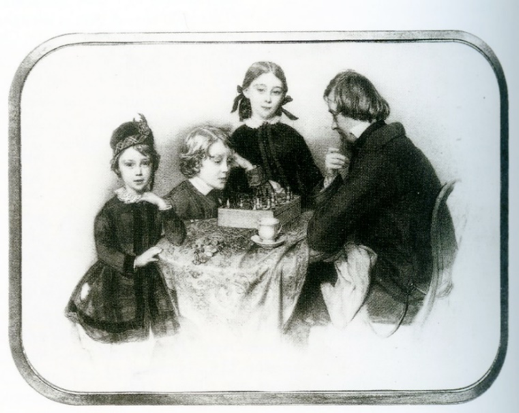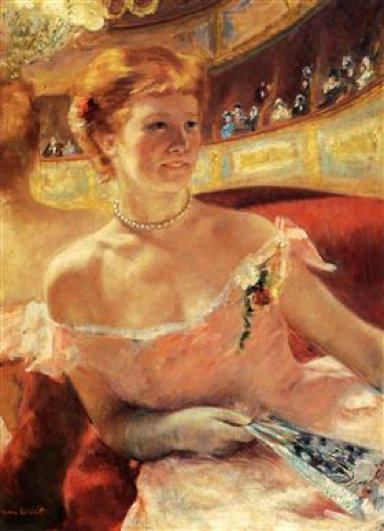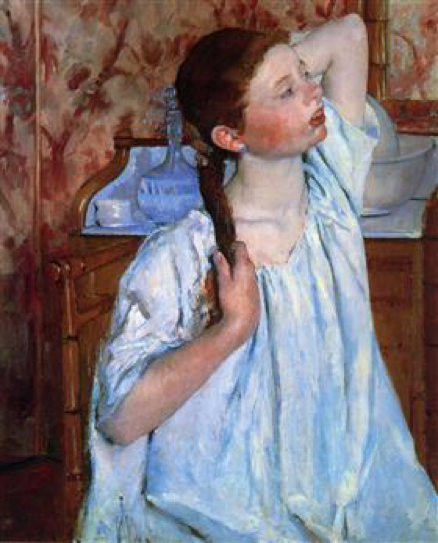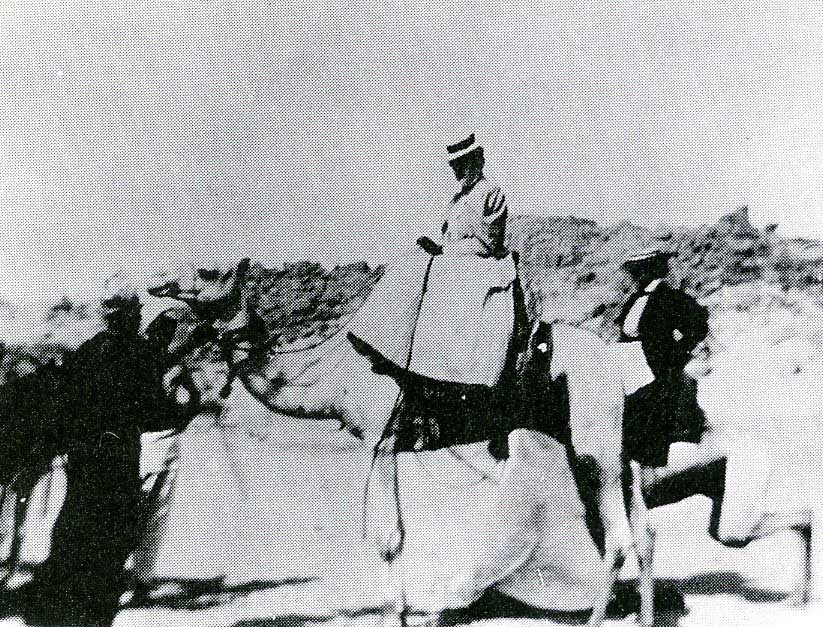Chronology
1844-1865 : Childhood and Early Education
Mary Stevenson Cassatt was born on the 22nd May 1844 in Allegheny City, a small town on the outskirts of Pittsburgh, Pennsylvania. This date is recorded in the family and parish archives but the Public Records Office incorrectly state May 24th, 1843 and on the tomb May 22th 1843, only the year is wrong.
Mary Cassatt's family was American upper middle class, descended from French Huguenot emigrants who came to the US from Holland in 1662 after leaving France before the revocation of the Edict of Nantes. They changed their name from Cossart to Cassatt in 1800.
Mary’s father Robert Simpson Cassatt (1806-1891) was a businessman with multiple interests. Her mother Katherine Kelso Johnson (1816-1895) came from a wealthy family and received an excellent education. She spoke French fluently. They went on to have seven children: Katherine and George died in infancy, Lydia Simpson Cassatt (1837-1882), Alexander Johnson Cassatt (1839-1906,) Robert Kelso Cassatt (1842-1855), Mary 91844-1926) and Joseph Gardner Cassatt (1849-1911).
In November 1851 the Cassatts sailed from New York to France. They were in Paris during Louis-Napoléon Bonaparte’s coup d’état (2nd December 1851) and discovered the charms of the capital, visiting its museums and expositions such as the International Exposition of Art and Industry in 1855. Their trip was motivated by a combination of educational opportunities for the children in excellent schools and medical care for Robert’s bone disorder. As the disease progressed, they moved to Heidelberg, Germany, then Darmstadt where they remained until the child’s death in 1855.
1866-1876 : Studies in Europe
In 1867 she decided to submit a canvas to the prestigious annual Salon but this was rejected by the jury. Mary, very disappointed, attributed this to the conservative, establishment values then in fashion and the Salon’s notorious anti-feminism.
The outbreak of the Franco –Prussian War necessitated a return to Pennsylvania which she found hard to bear. She made friends with John Sartain and his daughter Emily and painting and drawing with them helped lift her depression. Salvation came when the Catholic Bishop of Pittsburgh offered her a commission to go to Palma and copy two of Correggio’s paintings for the new cathedral.
After having spent the winter of 1874 in Rome, Mary returned to Paris and settled down near Place Pigalle. It was at this time that she established a lifelong friendship with Louisine Waldron Elder, the future Mrs. Havemeyer, who would become an unfailing supporter and promoter of the impressionists in the United States.
1877-1886 : The Impressionist Years
At the beginning of 1877, Degas visited Mary Cassatt’s studio with an invitation to show her work in Impressionist exhibitions. She happily accepted having become discontented with establishment art. Over the years Degas became Mary’s friend and confidant. Mary’s parents and sister Lydia moved to Paris, living at 13 Avenue Trudaine; her studio was in Rue Laval. She became friendly with Camille Pissarro.
In the summer, the Cassatts welcomed Mary’s brother Alexander’s family to Paris. They rented a villa in Louveciennes in the country by the Seine, enjoying the company of their nieces and nephews. Mary was able to paint and meet her artistic friends. She started advising Alexander on the acquisition of Impressionists works for his art collection, particularly Degas.
1882 and 1883 were dark years. Mary pulled out of the seventh Impressionist exhibition of 1882, her sister Lydia died on the 7th November and Eduard Manet died on the 30th April 1883..
1887 - 1893 : The Engraving Years
At the beginning of 1887 the Cassatt family moved to an apartment with a studio at 10 Rue de Marignan so that Mary could combine working and taking care of her elderly parents. She bought a press for her studio and a series of drypoints were presented for the first time in the United States in an exhibition organized by Durand-Ruel in Boston.
At the second exhibition of painter-printmakers, she showed a series of twelve drypoints, some acquatintes and a pastel. She was able to sell her prints to French and American collectors namely Gustave Larroumet, director of fine arts, George Lucas and Samuel P. Avery.
La Leçon made the cover of the first issue of L’Art dans les deux mondes, a magazine published by Durand-Ruel. With Degas and Berthe Morisot she visited the Japanese exhibition of color prints (more than 750) organized by the art dealer Siegfried Bing at the Ecole des Beaux-Arts. Mary was enraptured and deeply impressed by the asceticism of the Japanese prints.
 |
 |
 |
| Interior of a Tramway Passing Bridge, 1890-91, ©DR | The Letter, 1890-91, ©DR | The Kiss, 1890-91, ©DR |
In 1891 Mary Cassatt and Camille Pissarro were excluded from the third painter-printmaker exhibition as it was closed to non-French artists. They had to show their work in two independent exhibitions at Durand-Ruel’s Gallery. Mary continued to work on her series of portraits of women and children.
Her triptych received a lukewarm reception, like that of her first solo exhibition, - more than ninety works shown at the Durand-Ruel Gallery in Paris.
Her father died in December 1891.
1894-1924 : An American in the Oise
Mary Cassatt spent the summers of 1891, 1892 and 1893 at Bachivillers, entertaining her family and working on her mural. Unfortunately, the owner married and his new wife insisted on living in the château herself. Very disappointed, Mary had to look for another country retreat.
In 1895 Durand-Ruel organized Mary’s first solo exhibition in New York. This was a triumph with both critics and the public. In October her mother died.
Mary returned to the United States in January 1898 staying with her brother Joseph Gardner. She undertook about twenty commissioned portraits and exhibited her work at Durand-Ruel’s gallery and at the St. Botolph Club in Boston. She returned to France in the spring.
In 1902 Camille Mauclair published an article entitled “Miss Mary Cassatt; a painter of children”, in the magazine L’Art décoratif.
Mary met the American banker James Stillman in 1906 who went on to own the largest collection of her work and invited Ambroise Vollard, the art dealer, to Beaufresne.
That same year tragedy struck again with the premature death of her brother Alexander.
Mary made friends with the artist George Bidle and in 1913 and 1914 split her time between Le Mesnil-Théribus, Paris and Grasse, she was interviewed by the writer Achille Segard who published her first biography in 1913. Mary ceased painting in 1914 suffering from diabetes and cataracts and by 1921 she had become blind.
In 1915, Louisine Havemeyer organized an exhibition of works produced after 1900 at the Knoedler gallery in New York for the benefit of the suffragettes, a cause which she and Mary ardently supported and gave numerous lectures on her friend's career. Degas died in Paris on September 27, 1917.
She died on the 14th June aged eighty two in her Château de Beaufresne and was buried with her parents, her brother Robert and her sister Lydia in the family plot in the village cemetery of Le Mesnil-Théribus.
Source : This biography was compiled from Wendy Bellion's timeline, published in the catalog Mary Cassatt: Modern Woman (The Art Institute of Chicago, Harry N. Abrams, Inc., Publishers, 1998)

























